Sternocleidomastoid Muscle
Table of Contents
What is Sternocleidomastoid Muscle?
- The sternocleidomastoid muscle is a 2-headed neck muscle, true to its name bears joining to the manubrium of the sternum (Sterno), the clavicle (cleido), & the mastoid process of the temporal bone (mastoid).
- It is a lengthened, bilateral muscle of the neck, which functions to flex the neck both laterally & anteriorly, as well as rotate the head opposite to the side of contraction.
- The muscle is closely related to certain neurovascular structures that cross through the neck on their way, while to the head or to the periphery of the body.
Relation of Sternocleidomastoid Muscle
- The muscle locates very superficially so that it is both easily visible & palpable. The carotid pulse may be felt in the middle 3rd of the front edge. Beneath the sternocleidomastoid region runs a neurovascular bundle containing:
- Synonyms: Carotid space, Carotid fascia
- the common carotid artery (medial)
- the internal jugular vein (lateral)
- the vagus nerve (dorsal)
- the cervical ansa
- When placed in a central venous catheter (CVC), the medial edge of the sternocleidomastoid muscle provides a lead structure. Sensory branches of the cervical plexus combine dorsally to the muscle at the Erb’s point (punctum nervosum) which will be used as a space of puncture for local anesthesia.
- The sternocleidomastoid muscle plays a major role in the formation of the triangles of the neck.
Origin of Sternocleidomastoid muscle
- Sternal head:
- superior part of the anterior surface of manubrium sterni
- Clavicular head:
- the superior surface of medial 3 of the clavicle
Insertion
- The lateral surface of the mastoid process of the temporal bone, the Lateral half of the superior nuchal line of the occipital bone
Nerve Supply
- The nerve supply of sternocleidomastoid muscle is by the accessory nerve (cranial nerve XI) & direct branches of the cervical plexus (C2 &C3).
Blood supply
- Superior thyroid artery & the external carotid artery
Actions
- Sternoclavicular joint: elevation of clavicle & manubrium of the sternum.
- Bilateral contraction: atlantooccipital joint/ superior cervical spine: head & neck extension; Inferior cervical vertebrae: neck flexion
- Unilateral contraction: cervical spine: neck ipsilateral flexion, neck contralateral rotation
Variation of Sternocleidomastoid muscle
- The clavicular origin of the sternocleidomastoid differs greatly: in many cases, the clavicular head may be as small as the sternal; in others, it might be as much as 7.5 millimeters (0.30 in) breadth-wise.
- When the clavicular origin is thick, it is rarely further divided into several slips, differentiate by narrow intervals. More rarely, the adjoining margins of the sternocleidomastoid & trapezius are in contact. This would leave no space for the posterior triangle.
- The supraclavicular muscle origins from the manubrium beside the sternocleidomastoid & pass back the sternocleidomastoid to the upper place of the clavicle.
The function of Sternocleidomastoid Muscle
- Synonyms: Flexio lateralis cervicis
- A unilateral contraction of the sternocleidomastoid muscle flexes the cervical vertebral column to the same side (lateral flexion) & rotates the head to the alternate side.
- A bilateral contraction raises the head by dorsally straightening the upper cervical joints. At the same time, it flexes the lower cervical column occurring an overall flexing of the neck towards the chest.
- If the head is fixed, it raises the sternum & clavicle &, thus, expands the thoracic cavity (inspiratory breathing muscle).
Clinical Significance of Sternocleidomastoid Muscle
Torticollis/Wry Neck:
- Torticollis of the neck also named wry neck, is a dystonic condition justified by an abnormal, asymmetrical head/neck position, which may be due to many reasons. The term torticollis is derived from the Latin words tortus for collum & twisted for the neck.
- The most generic case has no obvious cause, & the pain & the difficulty with turning the head generally go away after a fewer day, even without any treatment.
- If the baby has the problem at birth, it is known as congenital muscular torticollis. It is the most common type.
- Torticollis in babies can also develop many other problems after birth. So it is termed as an “acquired torticollis” either than congenital. Acquired torticollis might be connected to other, more critical medical issues.
Stretching Exercise for Sternocleidomastoid Muscle
Table SCM Stretch
Instructions:
- Sitting in front of a table.
- Keep the chin in & down throughout this stretch.
- Place the left fist on the left side of the chin.
- Place the left elbow onto the table in front of you.
- Rest the weight of the head onto your fist.
- Tilt the head to the left.
- Apply more pressure to the chin to gear up the stretch.
- The goal is to feel a firm stretch on the right side of the neck.
- Hold for 30 secs.
- Perform on the alternate side.
SCM Stretch
Instructions:
- Tuck the chin in & downwards.
- Tilt the head to the right.
- Put the right hand on the opposite side of the head.
- Apply downward compression.
- Slowly turn the head to the left.
- The goal is to feel a firm stretch in the left Sternocleidomastoid.
- Hold for 30 secs, 3 rep.
- Repeat on the alternate side.
SCM Stretch Variation
Instructions:
- Place the fingers on top of the left collar bone.
- Pulling the skin down.
- Tuck the chin in & down.
- Slowly turn the head towards the left side.
- Tilt the head towards the right.
- The goal is to feel a stretch on the left Sternocleidomastoid.
- Hold for 30 secs, 3 rep.
- Repeat on the alternate side.
Chair Lean Stretch
Instructions:
- Sitting down on a chair.
- Using the right hand, grab onto the side of the chair.
- Keep the shoulder completely relaxed.
- Lean the body completely towards the left.
- Tuck the chin in & downwards.
- Tilt the head towards the left.
- Place the left hand on the right side of the head
- Apply downward compression.
- The goal is to feel a stretch on the right Sternocleidomastoid.
- Hold for 30 secs, 3 rep.
- Repeat on the alternate side.
Neck Elongation Stretch
Instructions:
- Tuck the chin in & downwards.
- Slide the head towards the right side.
- Elongate the right side of the neck in an upwards direction.
- The goal is to feel a stretch on the right side of the neck.
- Repeat on the alternate sides.
- Perform 30 reps, 3 rep.
Strengthening Exercise for Sternocleidomastoid Muscle
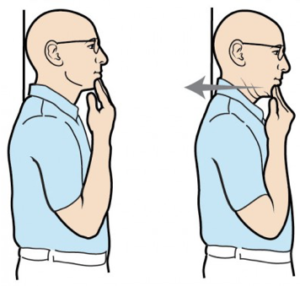
Chin tuck Exercise
- Sitting straight & look straight ahead with the ears parallel over the shoulders.
- Put two to three fingers on the chin.
- Stabilize the finger, pull the chin & head straight behind up to a gentle stretch is felt at the base of the head & top of the neck.
- Hold for 5 to 10 secs. Repeat seven to ten times.
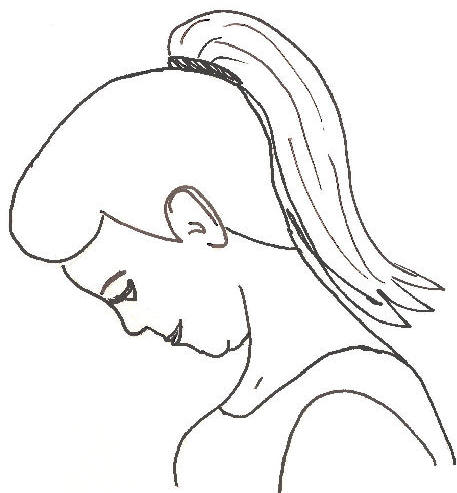
Neck flexion Exercise (Neck tilt)
- In Relax sitting position flex the head down to rest the chin on the chest (Flex the neck fully).
- Gently tense the neck muscles & hold for 4 to 8 secs.
- Return to the initial position & repeat seven to ten times.
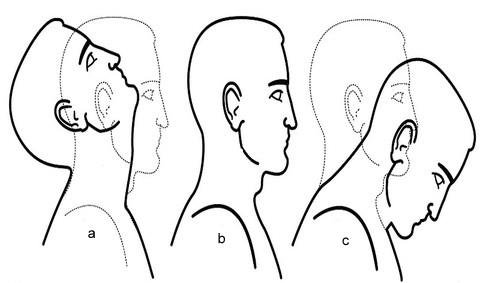
Neck extension exercise
- In Relax sitting position without arching the back, slowly move the head backward so you are looking upward.
- Hold for 5 to 10 secs. Return to starting position.
- This is a good exercise to do during working hours to prevent neck strain.
- Gently tense the neck muscles & hold for 5 to 10 secs.
- Return to a neutral position & repeat 10 times.
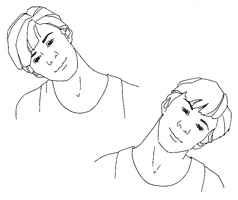
Neck flexion Exercise (side to side)
- Flex the head down towards the shoulder, & try to touch the shoulder with the ear (Without elevating the shoulder).
- Gently tense the neck muscles & hold for 8 secs.
- Return the head to a neutral position & repeat in the opposite direction.
- Repeat 10 times on both sides.
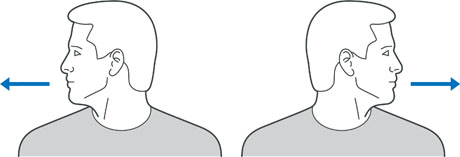
Neck Rotation exercise
- Rotate the head towards one side, keeping the chin at the same height & moving within comfortable limits.
- Gently stretch the neck muscles & hold for 8 secs.
- Return the head to the neutral position & repeat in the opposite direction.
- Repeat 10 times each on both sides.
Revolved Triangle Exercise
- Stand with the feet about four feet apart.
- Face the right toes forward & the left toes out at a slight angle.
- Square the hips & face forward in the same direction the right toes are pointing.
- Lift the arms up at the sides so they are parallel to the floor.
- Slowly hinge at the hips to fold forward, stopping when the torso is parallel to the floor.
- Bring the left hand to the leg, the floor, or a block, wherever you can reach.
- Extend the right arm straight up with the palm facing away from the body.
- Turn the gaze to look up toward the right thumb.
- Exhale to turn the neck to look down at the floor.
- Inhale as you return the gaze upward.
- Keep the rest of the body stable & continue these neck rotations as you stay in the pose for up to one min.
- Perform on the alternate side.
Upward Plank Exercise
- This pose allows you to passively hang the head back & down, releasing tension in the neck & shoulders. This lengthens & stretches the SCM, chest, & shoulder muscles.
- Make sure the back of the neck is fully relaxed to avoid compressing the spine. If it is uncomfortable for you to let the head hang back, you can tuck the chin into the chest & lengthen the back of the neck. Precise on engaging the neck muscles without straining.
- You can also allow the head to rest back on some type of support such as a chair, a wall, or stacked blocks.
- How to do- Come into a seated position with the legs straight in front of you.
- Press the palms to the floor alongside the hips.
- Lift the hips & bring the feet under the knees.
- Deepen the pose by straightening the legs.
- Open the chest and & let the head drop back.
- Hold for up to 30 secs.
- Do this pose up to three times.
Prone Cobra Exercise
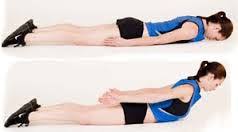
- This exercise is done by lying face downwards on the ground & uses gravity as resistance in the reinforcing process.
- Lying face downwards on the floor, put the forehead on a rolled-up hand towel for comfort.
- Place the arms by the side, and palms downwards on the ground.
- Touch the tongue on the upper palate of the mouth.
- Pinch the shoulder blades together & raising the hands off the ground.
- Roll the elbows inwards, palms outwards, & thumbs upwards.
- Gently raise the forehead about an inch off the towel keeping the eyes looking straight forward at the ground
- Hold the position for 7 to10 secs.
- Do10 repetitions.
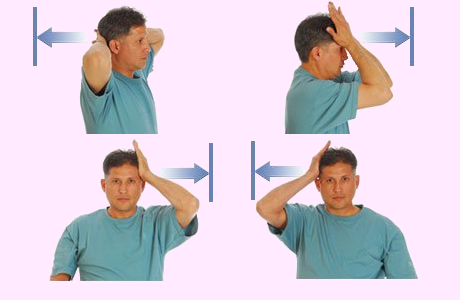
Isometric Neck Exercise
- Isometric neck exercise helps to strengthen the neck muscles. This exercise is mostly recommended by Physiotherapists from day 1st to relieve Neck pain.
Isometric Neck Exercise
How to perform this exercise In a sitting Position, - keep the Body straight, Put both hands behind the neck (as seen in the images), & try the neck to push pressure on the hands & At the same time Resist the neck muscles, both hands maintain align position for 4 to 5 secs & then relax.
The first day does 8 repetitions & the second day 10 repetitions. Do some exercise on the forehead & each side of the neck.
Do the exercise by pressing on the side of the head. Repeat 8 times, then alter sides.

Prone Rows Exercise
- Lie on the stomach with the arms dangling off the side of the bed (try angling the body so the head is facing the corner of the bed).
- Use a pillow under the stomach for comfort. Begin by pulling arms back while bending elbows & squeezing shoulders blades together then slowly return to the initial position.
- Do not lift the head up while pulling the arms back.
- Repeat 20 times. Perform 2 times a day.
Standing pushups exercise

- Stand about an arms-length down from the wall with the bases spread piecemeal.
- Place the hands on the wall, making sure that they parallel with the shoulders.
- Keeping the reverse straight, sluggishly bend or flex the elbows, bringing the upper body toward the wall.
- Unbend or extend the elbows & return to the starting position.
- Repeat 20 times. Perform 2 times a day.
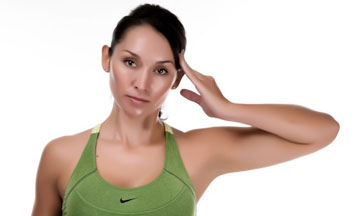
Lateral extension exercise
- Start by looking straight ahead. Slowly lean the head to the left side. Use the left hand for resistance, use the muscles in the neck to press against it. Hold for 5 to 10 secs, then return to the initial position.
- Then, slowly lean the head to the alternate side. Hold for 5 to 10 secs.
- Return to the initial position. Do 10 repetitions. This is a good exercise to do while in working hours, especially if you have to keep the head in a steady position for prolonged periods, as in working at a computer. Do this exercise every half hour to prevent neck strain.
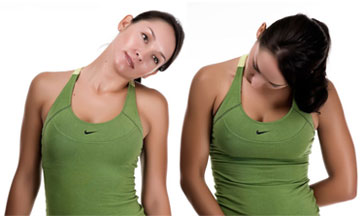
Tilted forward flexion exercise
- Sluggishly lean the head to the leftism. Using the left hand for resistance, use the muscles in the neck to press against it. Hold for 5 to 10 secs, also return to starting position.
- Also, sluggishly lean the head to the other side. Hold for 5 to 10 secs.
- Return to starting position. Do 10 repetitions. This is a good exercise to do during work, especially if you have to keep the head in a steady position for a prolonged time as in working at a computer. Do this exercise every partial hour to help with the prevention of neck tightening.


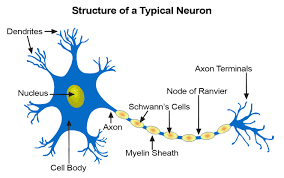
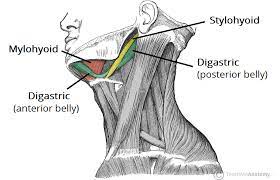

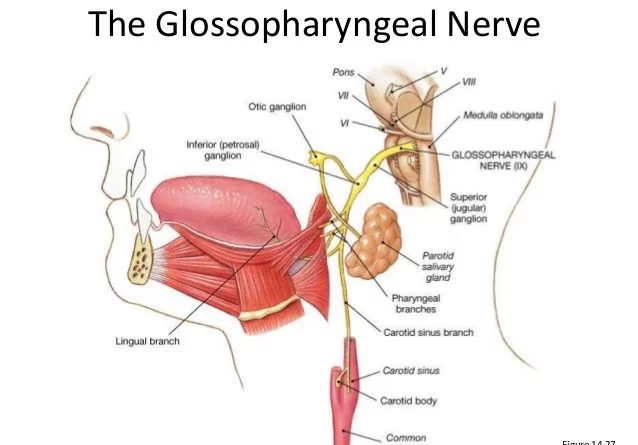
11 Comments